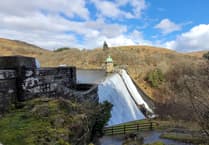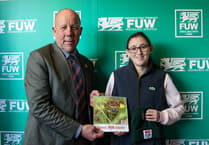THE Cambrian Mountains Society has backed calls to preserve the unique landscape as a working landscape and not simply a wilderness.
The classic image of the Cambrian uplands is of hills clothed in short grasses or peatlands, grazed by sheep alongside the wide range of wild birds which make their homes either seasonally or permanently in the area.
Some might imagine that this is land “untouched by the hand of man”, but nothing could be further from the truth.
Sheep farming was introduced by the Cistercians based at Strata Florida in the 11th and 12th centuries, and has been a mainstay of the local economy ever since.
Vast though those grazed expanses appear, in fact the area under grazing has already been severely reduced in the period following the Second World War.
At that time, the newly-created Forestry Commission moved in and bought up farms to plant conifer forests to grow timber for the British economy.
In the process, many ancient farms (and even older monuments) were lost to view, and at the peak of the trees’ growth before harvesting, most of the views in the affected areas – particularly in the Elenydd around Llyn Brianne, and further south toward Mynydd Mallaen – were reduced to regimented dark blocks of identical trees.
The loss of farming land naturally led to a loss of farming families, as people moved away to find employment elsewhere, in Wales and beyond.
The trend has continued, albeit less dramatically, ever since. In the last few years, even survivors such as the outdoor centre in Staylittle and the iconic Star Inn in Dylife have closed their doors.
The seminal Moriah Chapel in Abergwesyn, where in the 18th century the great hymn-writer William Williams and others prayed through the night for the Lord to bring the fire of religious revival to the Elenydd, is now falling into rapid decay as the last members of the congregation depart.
With the Welsh Government’s new call for 86 million additional trees to be planted in Wales, the spectre of an accelerated loss of families, communities and heritage looms once again, according to the Cambrian Mountains Society, which recently endorsed the Farmers’ Union of Wales call on the government to update land use rules, to ensure that large-scale afforestation is required to meet objectives that benefit rather than harm local economies.
To mitigate these problems, the Cambrian Mountains Society and others are working to educate people not just about the beauty and value of the area and the need to look after its habitats and wildlife, but also the fact that it is not simply wilderness but a working landscape.
“It is unfortunate that many of us imagine that going on holiday means finding a world without everyday rules – we talk about ‘escaping’ to the country,” said Cambrian Mountains Society trustee John Marshall.
“Arriving on a footpath or a hillside is arriving on someone’s field or sheepwalk. Litter in the countryside, gates left open for stock to escape, fires on so-called ‘wild’ campsites: all of them serve to alienate the farmers who live here, maintaining the land, tracks and hedges year-round.”
Lorna Brazell, spokeswoman for the Cambrian Mountains Society, added: “Farming sustainability can maintain food production (and hence food security and standards), boost ecosystem resilience and increase the vibrancy of wildlife diversity across the hills.
“Reaching net zero is a laudable, and essential, goal – but if it comes at the cost of destroying the communities whose future generations it is intended to benefit, then the victory would be Pyrrhic indeed.”





Comments
This article has no comments yet. Be the first to leave a comment.